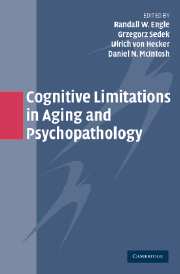Book contents
- Frontmatter
- Contents
- List of Contributors
- Preface
- Acknowledgments
- 1 Cognitive Limitations in Aging and Psychopathology: An Introduction and a Brief Tutorial to Research Methods
- SECTION I WORKING MEMORY AND COGNITIVE FUNCTIONS
- SECTION II AGING AND PSYCHOPATHOLOGY OF COGNITIVE CONTROL
- SECTION III ATTENTION, INHIBITION, AND REASONING PROCESSES
- 10 The Nature of Attentional Bias in Human Anxiety
- 11 Inhibition, Rumination, and Mood Regulation in Depression
- 12 Aging and Inhibitory Processes in Memory, Attentional, and Motor Tasks
- 13 Impairments of Memory and Reasoning in Patients with Neuropsychiatric Illness: Disruptions of Dynamic Cognitive Binding?
- 14 Generative Reasoning as Influenced by Depression, Aging, Stereotype Threat, and Prejudice
- Name Index
- Subject Index
- References
14 - Generative Reasoning as Influenced by Depression, Aging, Stereotype Threat, and Prejudice
Published online by Cambridge University Press: 20 May 2010
- Frontmatter
- Contents
- List of Contributors
- Preface
- Acknowledgments
- 1 Cognitive Limitations in Aging and Psychopathology: An Introduction and a Brief Tutorial to Research Methods
- SECTION I WORKING MEMORY AND COGNITIVE FUNCTIONS
- SECTION II AGING AND PSYCHOPATHOLOGY OF COGNITIVE CONTROL
- SECTION III ATTENTION, INHIBITION, AND REASONING PROCESSES
- 10 The Nature of Attentional Bias in Human Anxiety
- 11 Inhibition, Rumination, and Mood Regulation in Depression
- 12 Aging and Inhibitory Processes in Memory, Attentional, and Motor Tasks
- 13 Impairments of Memory and Reasoning in Patients with Neuropsychiatric Illness: Disruptions of Dynamic Cognitive Binding?
- 14 Generative Reasoning as Influenced by Depression, Aging, Stereotype Threat, and Prejudice
- Name Index
- Subject Index
- References
Summary
This last and interdisciplinary chapter begins with the observation that in many psychological subdisciplines that call themselves “cognitive,” there is a continuous debate about the specific nature of the mental limitations across different populations. Research in the cognitive aging area focuses on comparisons between older and younger adults in different basic cognitive functions (e.g., attention, working memory) and higher order cognitive functions (e.g., reasoning, comprehension). Research in the cognitive psychopathology area centers around similar comparisons and distinctions among emotionally disturbed versus emotionally stable participants. Finally, in the social cognition area, cognitive limitations and biases produced by strong prejudice or stereotypes are central issues. Researchers from the previously-mentioned domains often refer to the same psychological mechanisms that might interfere with effective cognitive processing. Just to mention a few, these include lack of motivation or cognitive initiative, limited cognitive resources, inefficient inhibitory mechanisms, or oversimplified strategies of information processing. However, there are very few attempts to directly compare the mechanisms underlying those impairments and limitations across different research domains using the same cognitive tasks.
In this chapter, we describe one of our research projects that aimed to compare the performance of individuals from different populations on the same generative reasoning tasks. The populations included depressed versus nondepressed students, older versus younger adults, students threatened by stereotype versus control students, and finally, students with high versus low levels of ethnic prejudice. We noticed that similar kinds of explanations have been suggested to explain the reduced cognitive performance in some of these groups.
- Type
- Chapter
- Information
- Cognitive Limitations in Aging and Psychopathology , pp. 377 - 401Publisher: Cambridge University PressPrint publication year: 2005
References
- 2
- Cited by



